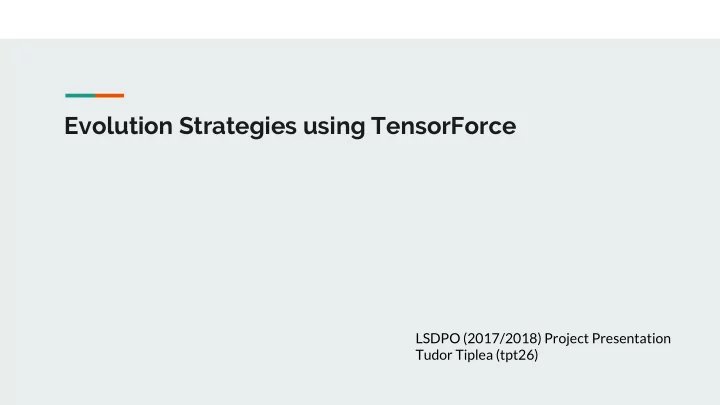

Evolution Strategies using TensorForce LSDPO (2017/2018) Project Presentation Tudor Tiplea (tpt26)
What is TensorForce? Open-Source Reinforcement Learning Library ● Built on top of TensorFlow ● Provides a strict separation of agents, environments and update logic ● A number of out-of-the-box state-of-the-art RL algorithms already implemented: ● A3C, DQN, Double-DQN, etc. ○
Why is it useful? ● Suppose you want to employ deep RL to control some aspect of your system Lots of resources and introductions to theoretical RL ● Also, lots of starter agents and their applications available online ● However, much of the existing code has several disadvantages. E.g.: ● Tight integration with simulation platforms ○ Fixed network architectures ○ TensorForce provides the out-of-the-box agents, but they are highly configurable ● It also employs a shift of paradigm: the environment calls out to the agent when it needs a decision rather ● than the other way around
Evolution Strategies An alternative to MDP-based RL techniques such as Q-learning or Policy Gradient ● A heuristic search procedure inspired by natural evolution ● At each iteration (generation): ● Perturb a population of parameter vectors ○ Evaluate the objective function for each ○ Best performing ones are recombined to form the population at the next step ○ Can be scaled and parallelised between multiple workers, with limited intercommunication ●
Non-parallelised algorithm
Work plan Connect the existing weight update part of the simple ES algorithm to a model, producing the ● first agent Implement the parallelised ES agent to run in multi-threaded manner on my laptop ● Evaluate the two on simple environments (due to long training time) from OpenAI Gym ● Compare against already implemented agents such as A3C and DQN ●
Possible extensions First, set up an EC2 instance using a student account ● Evaluate the implemented agents in more complex environments, such as Atari 2600 games ● Extend the parallelised ES agent to run in a distributed manner, across multiple machines ● Evaluate the distributed ES agent ●
Questions Thank you!
References [1] TensorForce: https://github.com/reinforceio/tensorforce [2] Evolution Strategies as a Scalable Alternative to Reinforcement Learning: https://arxiv.org/abs/1703.03864
Recommend
More recommend